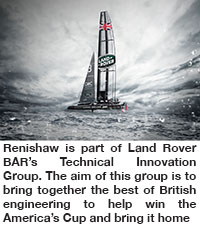Enhanced control solution for Land Rover BAR’s America’s Cup race
10/05/2017
When Olympic hero Sir Ben Ainslie took the helm of Britain’s hope to bring the America’s Cup home for the first time in 166 years, he realised that his Land Rover BAR team needed the very best in British manufacturing, design and innovation. Since 2013, the AC72 and ACC class wing-sail catamarans have changed the conventional view of what a sail boat should look like. Adoption of advanced data-led simulation to aid the design process has allowed the construction and precise optimisation of complex aero- and hydrodynamic structures made of high-tech composite materials. Land Rover BAR’s boat Rita has been designed and built with the latest technologies to give the greatest advantage possible against the best in the world.
Since 2013, the AC72 and ACC class wing-sail catamarans have changed the conventional view of what a sail boat should look like. Adoption of advanced data-led simulation to aid the design process has allowed the construction and precise optimisation of complex aero- and hydrodynamic structures made of high-tech composite materials. Land Rover BAR’s boat Rita has been designed and built with the latest technologies to give the greatest advantage possible against the best in the world.Renishaw, a global engineering company, is part of Land Rover BAR’s Technical Innovation Group. The aim of this group is to bring together the best of British engineering to help win the America’s Cup and bring it home. This is a huge challenge unlike any other in world sailing.
During Rita’s development, Land Rover BAR realised that precision knowledge of the wing settings could be compromised by the tenuous link between the hydraulic actuators and the control surfaces or flaps. These linkages are ropes with a high degree of compliance, so the position of each actuator is often only an approximate measure of the actual flap angle. Land Rover BAR called on metrology experts at Renishaw to design a solution.
Dr Finlay Evans, Technical Leader for Renishaw’s Encoder Products Division, and his team rose to the occasion and designed a bespoke magnetic encoder solution, based around LinACE™ technology from Renishaw’s associate company RLS. LinACE is an extremely robust absolute linear cylindrical encoder system designed for integration into hydraulic, pneumatic and electromechanical actuators as a feedback element for position or velocity closed-loop applications.
The position encoders were installed on the control surfaces of both the wing (flaps) and the port and starboard rudders. Numerous changes were made to ruggedise the LinACE encoder and make it durable enough for life at sea. For instance, the encoder readhead (sensor) was encapsulated to protect its internal microelectronics and special gimballed armatures were designed to isolate the encoder from structural vibrations and wing flex. Correct rideheight has also been ensured by a magnetic bond between the readhead and its stainless steel partial arc scale.
These design features are crucial to the success of the overall encoder system. Any design failures would have meant failure to deliver an encoder in the time scale requested – the biggest challenge that Finlay and his team faced. It was literally a race against the clock. In crossing the finishing line, Renishaw has provided Land Rover BAR with a position encoder control solution truly befitting of their world-class status.
A video created by the Land Rover BAR team also explores how the Renishaw encoders are helping to position the wing to reach maximum speed.
Land Rover BAR is also using Renishaw’s metal 3D printing technology to manufacture several parts for the boat’s hydraulic systems.
www.renishaw.com